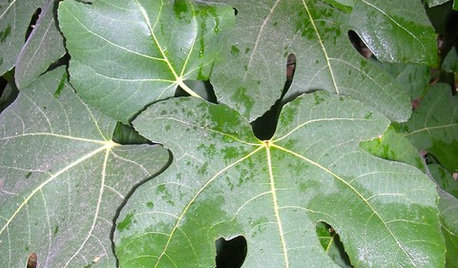Tiny fig tree leaf color
noss
13 years ago
Related Stories

HOUSEPLANTSSee How Fiddleleaf Fig Trees Can Liven Up Your Decor
The tropical houseplant with big green leaves adds a cheerful and striking design element to rooms
Full Story
GARDENING GUIDESGreat Design Plant: Common Fig
A full form and delicious fruits make this Middle Eastern tree a favorite in gardens around the world
Full Story
HOUSEPLANTSPlay Up Some Fiddleleaf Figs for a Lively Indoor Tune
Strike a dramatic chord in a minimalist scene or a country note in a rustic setting — fiddleleaf fig plants harmonize with any style
Full Story
ARBOR DAY8 Reasons to Plant a Great Tree
Beauty is its own reward, but the benefits of planting the right tree in the right place go way beyond looks
Full Story
TINY HOUSESHouzz Tour: A Custom-Made Tiny House for Skiing and Hiking
Ethan Waldman quit his job, left his large house and spent $42,000 to build a 200-square-foot home that costs him $100 a month to live in
Full Story
SMALL HOMESMaking Room: Discover New Models for Tiny NYC Apartments
Explore a New York exhibition of small-space design proposals that rethink current ideas about housing
Full Story
GARDENING GUIDESHow to Keep Your Citrus Trees Well Fed and Healthy
Ripe for some citrus fertilizer know-how? This mini guide will help your lemon, orange and grapefruit trees flourish
Full Story
EDIBLE GARDENSHow to Grow 10 Favorite Fruit Trees at Home
Plant a mini orchard in fall, winter or early spring to enjoy fresh-off-the-tree fruit the following year
Full Story
HOLIDAYSChristmas Tree Decorating the Painless Way
Holidays are for carols, not cussing. Make tree trimming less work and more fun with this guide at your side
Full Story
FALL GARDENING6 Trees You'll Fall For
Don’t put down that spade! Autumn is the perfect time for planting these trees
Full Story





dieseler
tapla (mid-Michigan, USDA z5b-6a)
Related Professionals
Eden Prairie Landscape Architects & Landscape Designers · Maple Heights Landscape Architects & Landscape Designers · North Richland Hills Landscape Contractors · Frederick Decks, Patios & Outdoor Enclosures · Gladstone Decks, Patios & Outdoor Enclosures · Saint Louis Park Decks, Patios & Outdoor Enclosures · Verona Decks, Patios & Outdoor Enclosures · Annapolis Fence Contractors · Fort Lauderdale Fence Contractors · Glenpool Fence Contractors · Leander Fence Contractors · Lexington Fence Contractors · Spanaway Fence Contractors · Wallingford Fence Contractors · Hermosa Beach Fence ContractorsnossOriginal Author
tapla (mid-Michigan, USDA z5b-6a)
nossOriginal Author
tapla (mid-Michigan, USDA z5b-6a)
tapla (mid-Michigan, USDA z5b-6a)
nossOriginal Author
tapla (mid-Michigan, USDA z5b-6a)
oregonwoodsmoke
nossOriginal Author